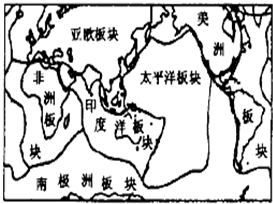问题
问答题
读六大板块示意图,回答下列问题:
(1)世界最高的高原是由于______和______板块相互挤压造成的.
(2)一般来说,板块的内部比较
______,而交界处比较______,多火山、地震.
(3)世界两大火山、地震带是:______地带、______地带.
(4)由于板块运动,红海在不断______,而地中海则在不断______.
(5)我国台湾岛多地震,是因为台湾位于______和______ 的交界地带,地壳比较活跃.

答案
读图可知,(1)世界最高的高原是由于印度板块和亚欧板块板块相互挤压造成的.
(2)一般来说,板块的内部比较稳定,而交界处比较活跃,多火山、地震.
(3)世界两大火山、地震带是:环太平洋地带、地中海-喜马拉雅山地带.
(4)由于板块运动,红海在不断扩张,而地中海则在不断缩小.
(5)我国台湾岛多地震,是因为台湾位于亚欧板块和太平洋板块的交界地带,地壳比较活跃.
故答案为:
(1)印度板块; 亚欧;
(2)稳定; 活跃;
(3)环太平洋; 地中海-喜马拉雅山;
(4)扩张; 缩小;
(5)亚欧板块;太平洋板块.
